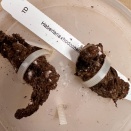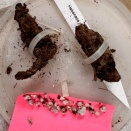Orchid Culture - 2024 Questions & Answers
If you like what you see, feel free to leave a donation; just click on the Tip Jar. Thank you!by Sue Bottom, from the St. Augustine Orchid Society Newsletter. Email us with any orchid question, if we can't answer it we'll find someone who can! Send photographs too!
Weird Phal Flower Spike
Q. I have a grocery store no-id Phal that seems very healthy but has leaves that are significantly twisting and both its flower spikes emerged normally then started dramatically twisting even though the LED grow lights are directly above it. I am wondering if the leaves are showing chlorotic streaking and whether the plant might be virused.A. Some phals have certain species in the background that have markings similar to what your phal is showing. That flower spike is very confused. I have tried straightening them out and all I do is break them. It's a lot twistier than what I have seen in the past, so maybe there's some genetic predisposition, or perhaps you moved them on the shelf to water them and the light orientation changed? At any rate, you'll have to wait til next year for hopefully a better flower spike. The plant looks healthy. (Apr-24)
Catasetum Has New Growth Starting
Q. I see new growth on this Catasetum that still has green leaves, so I’m afraid to repot. Can this wait until the next potting clinic next month? Should I start watering it?
A. The best time to repot any orchid is immediately before the new roots start growing. With most orchids, you don't know when the new roots are starting until you see new green root tips. With catasetums, you know when you see the new green growth begin to form that you have a week or 10 days before the new roots will start growing. This short window is the best time for you to repot your catasetum. That catasetum has outgrown its pot, so you should repot it over the next few days.
(Apr-24)
Leaves Falling Off
Q. This Bc. Yellow Bird spent the winter in my eastern exposure bathroom. As blooms faded, I moved it to a southern exposure under my pool screen. Now almost all leaves are falling off. The leaf tips stared browning and then fell off above the pseudobulb.A. Looks like you've got some cleaning up to do! Get a sterile tool and cut off all the severely damaged leaves, probably close to the base of the leaf. That will remove the source of the problem, which I would suspect to be bacterial in origin. Then, spray it with some copper, and put it back in the eastern exposure bathroom until it perks up. I'd guess that you have been growing in the same pot for a while judging by the density of the pseudobulbs. Try lifting it up by the vegetation and see if there's any wobble in the pot. If there is, repotting is in your future, but I'd wait a bit on this to see what dead/infected areas have to be cut out.
Some guesses as to what might have caused it. It could have been cold exposure after it's winter nap inside, or perhaps the big day night temperature changes caused condensation on the leaf surfaces at night and this was the starting point for the disease issue, or there could have been dripping cold water from above onto the leaf surfaces also causing cold damage. I am guessing the damage happened fast rather than slow suggesting it's bacterial rather than fungal. Your normal fungicides won't do anything for a bacterial infection. The good news is these guys are very resilient, so if you can stabilize the plant, by mid summer you'll hardly know you had a problem. (Apr-24)
Cycnoches Soft Spot
Q. I’ve treated this Wine Delight with Thiomyl and cinnamon. I was waiting until the leaves died back and hoped it would callus over. Now, it is withering. Should I pull this whole section away from the other two? I don’t want to lose the whole orchid. Should I just cut below that soft section, or is it better to bite the bullet and get rid of that whole section?A. That is a rot inside the pseudobulb, beyond the reach of chemicals. You'll have to cut away the infection, cut until you see no discoloration on the inside of the pseudobulb. You may be able to place the uncontaminated part of the pseudobulb halfway into some sphagnum moss and see if it will sprout keikis eventually. Cut that bad pseudobulb away from the mother plant so the plant will be safe. (Mar-24)
Habenaria Tubers
Q. These habenaria tubers are stored in a plastic bag. I'm watching for any sign of life. They have what looks like salt crystals in the tubers, which I scraped off. I have the AOS Habenaria Culture sheet and I have read the issue of SAOS 2022 newsletter that featured Habenaria. According to that sheet, I probably should put them in dry mix just in case they are alive. I will have to place them horizontally since I don't know which end is up.A. The tubers are not dead, they are just sleeping. I am guessing what looked like crystals was probably perlite from the ProMix, and it was just grown into the tuber, probably best to just leave it attached. I think the top of the tuber is to the right in your picture. In the lower one, you can see the vestiges of the old tuber, that is now dried up and dessicated. The roots grow from the top of the tuber. None of my tubers have woken up yet, though I saw Sarah Hurdel's post where lots of hers have started growing. Just be patient and check the tubers every week or so. I'm torn too, and thinking maybe I should just start potting them up and leaving the top third of the tuber uncovered so I can finish the repotting process after they start growing, but so far I have resisted the urge. (Mar-24)
Sudden Lesions on Dendrobium
Q. I have a dendrobium orchid that has done really well until this past week when it developed lesions (that I noticed). I treated it with Thiomyl for Anthracnose. Any ideas?A. That looks like a cercosporoid fungus, dendrobiums seem to be very susceptible to it. You'll have to remove the severely damaged leaves that contain fungal spores. Thiomyl is a good preventative, but it is not curative, that's why you have to remove the source of inoculum. (Mar-24)
Phal Leaves Getting Soggy
Q. The leaves on two of my Phalaenopsis plants are getting soggy. What could be the problem?A. That's bacterial soft rot, caused by Erwinia (also called Pectobacterium). Cut away the damaged leaf quickly before the infection reaches the crown, and douse with hydrogen peroxide or a copper bactericide. Spray all the surrounding plants too! (Feb-24)
Leaves Are Crinkled
Q. My plant's leaves are all crinkled. I water when it seems dry, and it's sitting inside with no direct sun but near lots of windows.A. When the leaves on oncidiums get that accordion look, it means they're not getting enough moisture. You'll have to step up the watering frequency a bit. Good luck! (Feb-24)
Gray and Brown Leaf Spotting
Q. I separated this one immediately from all the other orchids. The leaves have gray and brown spotting. Would you please tell me what's wrong and what I should do.A. I think you probably have a mite infestation on that dendrobium. They spread pretty easily, so check your other thin leaved orchids like oncidiums; they also will go after the soft tender phal leaves. The first step is take it to the kitchen sink and wash all the leaves, top and bottom. Then get a spray bottle of isopropyl alcohol and spray the entire plant, top and bottom. You may have to repeat this weekly for a couple of weeks. Here's a link to the website, scroll down to the mites section for some other ideas. (Feb-24)
Mount Neofinetia falcata?
Q. These Neof. falcata arrived in tiny pots with loose large bark. I just mounted them on cork with sphagnum moss and removed it. Would they be safer in a clay pot? I read that the Japanese mount/plant them on a sphagnum moss ball they place in a bowl.A. I referred this question to Suzanne Susko and Joanne Stygles, who specialize in these orchids. Suzanne wrote: Those Neos look great. The grower you got them from knew how to grow them. I use the traditional Japanese/Korean style of growing which is a sphagnum ball, but with a twist. The center of the sphagnum ball is filled with a stack of peanuts so the center of the pot gets constant air flow. The roots of the plant are contained in about ½ of sphagnum surrounding the peanuts. They need to dry out between watering, but can be in a moist environment for several days. I water only when the sphagnum is very crispy; you can easily kill Neos by overwatering. You can use two small net pots to achieve the same result. Take a small net pot inserted into the center of the roots at the base of the leaves. Holding it tight, surround the roots with about ½ inch of sphagnum. Place the whole thing into a slightly larger net pot leaving the bottom open for air flow.
Joanne added: I grow the majority of my neo's in 3A & 5A New Zealand sphagnum moss. I place the roots on top of a 3A mound created with an air hole using a moss pole, then wrap the 5A around the roots. The effect is similar to Suzanne's method. I also have a few which are attached to cork and wood mounts. Those are not my named varieties, but rather what neo growers call Furan (wind orchids). They do well, however I find they do not grow as well or as strong. Neo's are not fast-growing orchids for the most part, and some of the named varieties take years to even make what we call a clump. You can use a regular clay pot with either small bark or loose sphagnum, cork, or traditional method. All will help you enjoy this fascinating species. To us Neo nuts, it's not a vanda, it will always be a Neofinetia falcata. I have attached a link to Jason Fischer's Orchid Limited webpage, he is one of three US based growers of Neo's and is an expert with these beauties. (Jan-24)
White Balls Around Roots
Q. Is this a fungus?A. I think that's one of the bad ones, Sclerotium or Southern Blight, though I've never seen it on a vanda before. Carefully remove it to the trash, all those little balls that look like mustard seeds are the resting form of the fungus, and will spread the disease readily to nearby plants. I hope that vanda wasn't one of your favorites! (Jan-24)
Inadequate Drainage
Q. I misplaced this Dendrobium in a pot with inadequate drainage. It’s in half death throws but I don’t know if I should cut anywhere or just leave it out in the air for a bit.A. It looks like you've got rot coming up from the roots into the cane, and it looks like it's affecting all but maybe one cane. I suspect the nobile's days are numbered. (Jan-24)


















